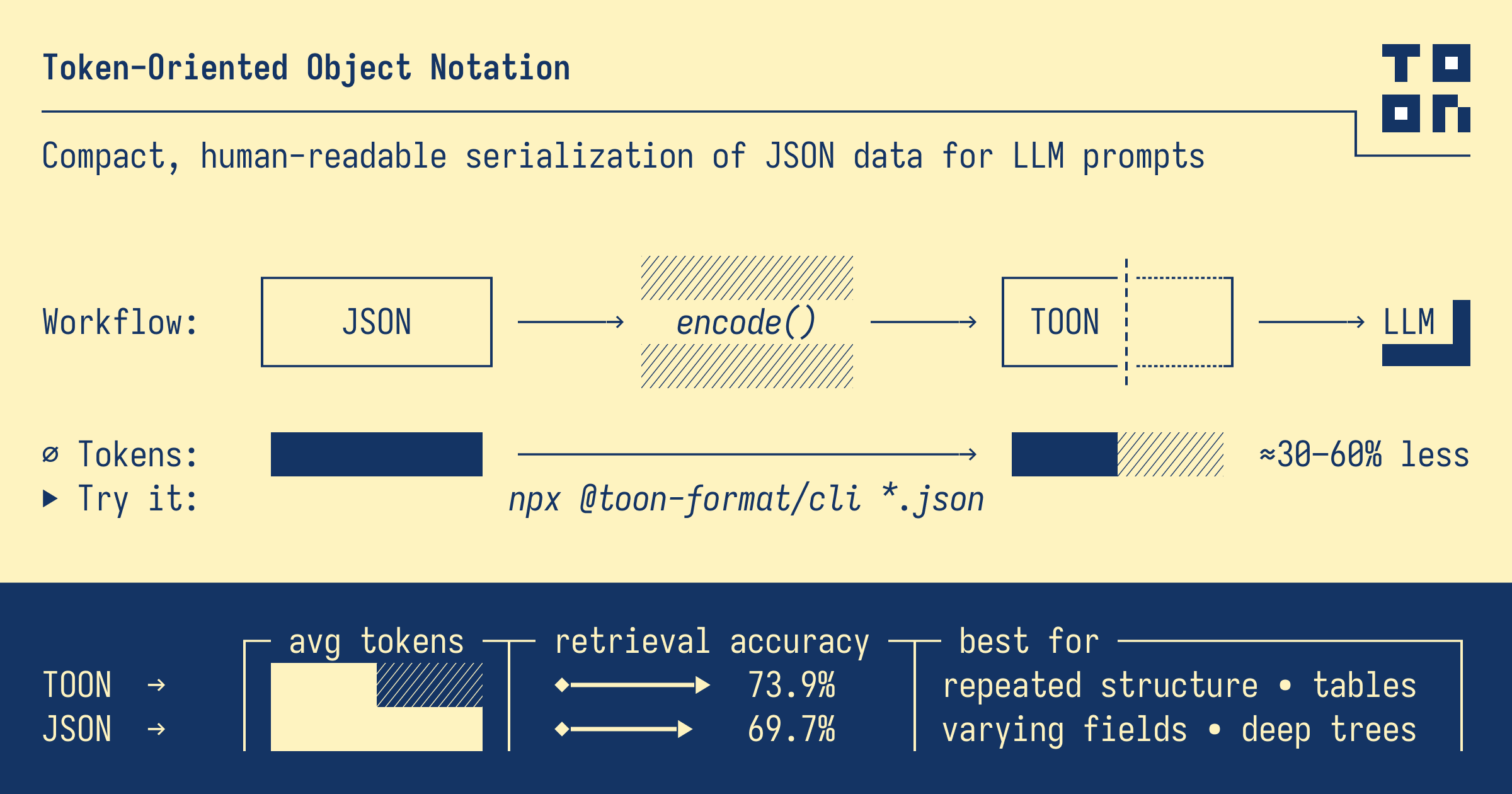Beware When Using TOON
TOON is a new serialization format, but has many pitfalls.

Sam Lijin
We’ve had a lot of users ask us for TOON support, so starting in BAML 0.214.0, you’ll be able to use {arg|format(type="toon")} in your BAML functions!
We do see a number of issues with TOON that we want our users to be aware of, though, and also explain why we're not adding native support for TOON outputs:
- it’s not general-purpose: it’s an optimization for a specific shape of data;
- its schema description capabilities are weak;
- LLMs do not understand numbers.
TOON is not a general-purpose input format
TOON warns in its own documentation that you should not use it if your data is deeply nested, non-uniform, or purely tabular. If you use TOON, you should be sure
- that your use case is a good fit for TOON, and
- that if the shape of your data changes, that it will continue to make sense to use TOON
For example, if you use TOON to render a Product[], that's simple enough:
products[2]{name,color}:
Cotton Crewneck T-Shirt,Blue
Water-Resistant Running Shoes,Black
but if you make a simple change to Product, like add an empty tags field, and long-form text description and careInstructions fields, TOON will just look like malformed YAML:
products[2]:
- name: Cotton Crewneck T-Shirt
color: Blue
tags[0]:
description: "A soft, lightweight crewneck made from breathable cotton. Designed for everyday wear with a relaxed fit suitable for layering or wearing on its own."
careInstructions: Machine wash cold with similar colors. Tumble dry low or hang to dry. Avoid bleach. Warm iron if needed.
- name: Water-Resistant Running Shoes
color: Black
tags[0]:
description: Durable athletic shoes built with a water-resistant upper and cushioned midsole for long-distance comfort. Suitable for road running and light trails.
careInstructions: Brush off dirt after use. Clean with mild soap and warm water. Air dry away from direct heat. Do not machine wash or dry.
TOON is a bad output format
If you really want to use TOON as an output format, you can use few-shot prompting to inject a TOON schema into your prompt template, like so, and then manually parse the TOON output from the returned string:
function ToonOutputPlease(input: Input[]) -> string {
client "your-client-here"
prompt #"
Data is in TOON format (2-space indent, arrays show length and fields).
<toon>
{{ input|format(type="toon") }}
</toon>
Task: Return only users with role "user" as TOON. Use the same header. Set [N] to match the row count. Output only the code block.
"#
}However, you should be aware that we do not recommend this. TOON is a bad output format.
Limited schema capabilities
TOON doesn't actually have a mechanism for describing output schemas - it relies on few-shot prompting that describes field names. For the same reason, TOON also can't describe the intended type of an output field.
BAML's {{ ctx.output_format }}, by contrast, is designed to not only support any schema, but also to make it easy for you to describe your schema in an LLM-friendly way:
@aliasand@descriptionto attach LLM instructions to fields and types;- hoisting for recursive types (e.g.
class Node { child: Node? }); - fields with union types are represented as
orinstead of|by default.
We don't see any way to model any of these features in TOON.
LLMs do not understand numbers
TOON requires that arrays are encoded with their length:
encode({
items: [
{ sku: 'A1', qty: 2, price: 9.99 },
{ sku: 'B2', qty: 1, price: 14.5 }
]
})items[2]{sku,qty,price}:
A1,2,9.99
B2,1,14.5For an LLM to produce output in TOON format correctly, therefore, an LLM must be able to count. Unfortunately, LLMs are known to be bad at not just counting, but are bad at any task that involves understanding the semantics of numbers.
In fact, if I ask gpt-5.1 - a state-of-the-art model released last week - to do some non-trivial counting, its answer will be wrong:1
{
"fn_count": 82,
"fn_names": [<array with 68 elements>],
"type_count": 8,
"type_names": [<array with 8 elements>],
"import_count": 54,
"import_names": [<array with 55 elements>]
}
Now let's say we ask for a model to return output in TOON format, and it makes this mistake:
- What do you want to show to your end user?
- What should the TOON parser do, and how will it allow you to achieve (1)?
We don't think there are good answers to either of these questions, and in fact, see this as a fundamental design flaw in TOON. (Maybe this is fixable by removing array lengths from TOON?)
Future Work
We have a lot of ideas in the backlog for improving our output parser (syntax for mixed output formats, e.g. asking for code snippets in XML; custom handling for bad LLM outputs; prompt optimizer tooling) which we want to explore in the long term.
In the meantime, we're hard at work on a slew of projects tackling the full lifecycle of building AI-powered software, and making it easier to debug, test, and monitor your pipelines. Keep an eye out for the calls for beta testers in the community Discord!
Footnotes
-
Note that this prompt has to be super insistent on answering in the specified format because without it, gpt-5.1 will say that it's not good at counting. ↩
